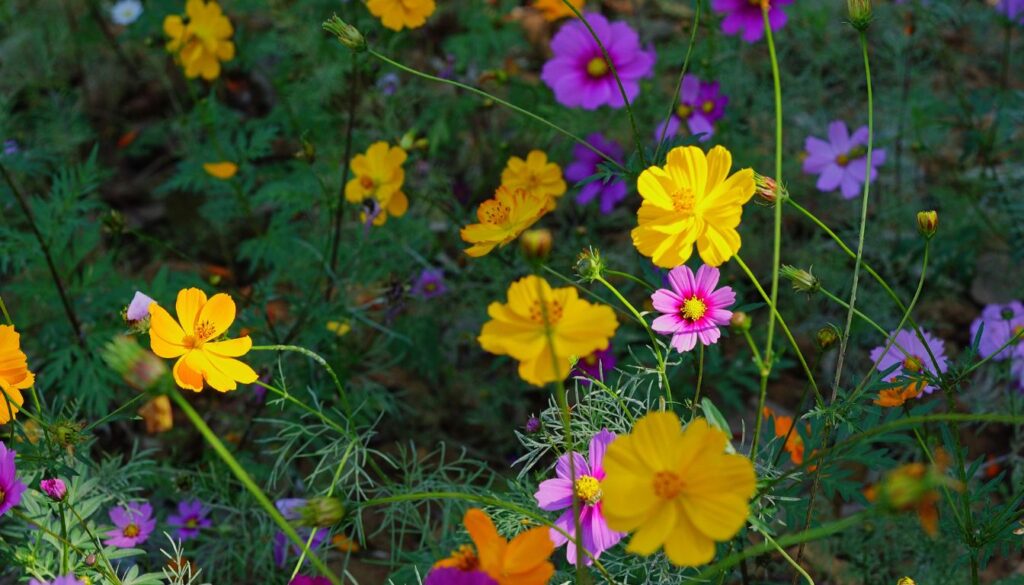If you’re looking to add a splash of color to your garden, cosmos plants are a fantastic choice. These vibrant flowers not only brighten up any space but are also surprisingly easy to care for. With their stunning blooms and ability to attract pollinators, cosmos can transform your outdoor area into a lively haven.
I’ve discovered that nurturing cosmos isn’t just rewarding; it’s also a great way to connect with nature. Whether you’re a seasoned gardener or just starting, understanding the essentials of cosmos plant care can lead to a flourishing garden. Let’s dive into the simple yet effective tips that will help you cultivate these beauties and enjoy their charm all season long.
Understanding Cosmos Plants
I find cosmos plants to be a delight in any garden. Their bright blooms and low maintenance needs make them ideal for gardeners at any level.
Types of Cosmos Plants – Cosmos Plant: Care Tips for Vibrant Blooms All Season
Cosmos bipinnatus, commonly called garden cosmos, features stunning pink, white, and purple blossoms. Growing between 60 cm and 2.5 m tall, it blooms from late summer until frost. Thriving in full sun and well-drained soil, it’s low-maintenance and attracts bees and butterflies, making it a perfect addition to gardens and meadows
Cosmos sulphureus, commonly called yellow cosmos, is a vibrant annual plant celebrated for its sunny yellow and orange blossoms. A member of the Asteraceae family, this hardy plant grows up to 1.2 meters tall and thrives in full sun and well-drained soil. Blooming from summer through early autumn, it is drought-tolerant and easy to grow, making it perfect for brightening gardens and attracting pollinators like bees and butterflies.
Cosmos atrosanguineus, otherwise known as chocolate cosmos, is a fascinating perennial plant known for its deep brown, almost maroon petals that exude a delightful chocolate-like fragrance. This unique plant, native to Mexico, typically grows up to 60 centimeters tall and thrives in full sun with well-drained soil. Blooming in late summer, it adds an exotic touch to gardens and attracts pollinators like bees and butterflies.
Ideal Growing Conditions
Cosmos plants thrive in full sun. They need at least six hours of direct sunlight daily for optimal growth. Well-draining soil promotes healthy roots. I prefer sandy or loamy soil with a pH between 6 and 7. Watering should be moderate, and allow the soil to dry slightly between waterings. Excess moisture can lead to root rot. In terms of temperature, cosmos plants enjoy warmth, thriving in conditions between 70°F and 85°F. These plants tolerate drought, making them perfect for busy gardeners who may forget to water occasionally.
Cosmos Plant Care Basics

Caring for cosmos plants is straightforward and rewarding. I’ll cover essential aspects to help you nurture these vibrant flowers effectively.
Soil Requirements – Cosmos Plant: Care Tips for Vibrant Blooms All Season
Cosmos thrive in well-draining soil. I recommend sandy loam or loamy soil for optimal growth. Soil pH should range from 6.0 to 7.0. If your soil has high clay content, mixing in organic matter can improve drainage. Good soil helps prevent root rot and promotes healthy plants.
Light and Temperature Needs
Full sun is a must for cosmos plants. Bright light helps them grow strong and produce abundant blooms. I find that planting them in a location with at least six hours of sunlight each day works best. They enjoy warm temperatures, ideally between 70°F and 85°F. On chilly nights, it’s best to cover them to keep them cozy. Remember, too much humidity can dampen their spirits, so ensure good air circulation.
Watering Guidelines
Water cosmos plants moderately. It’s essential to let the soil dry out between waterings. I usually check the top inch of soil; if it feels dry, it’s time for a drink. Early morning is the best time to water, preventing evaporation and keeping the plants refreshed. Overwatering can lead to soggy roots, so be cautious. If they start drooping, don’t panic, just check the soil! With proper attention, cosmos plants can flourish all season long.
Fertilizing Cosmos Plants
Fertilizing cosmos plants promotes vibrant blooms and healthy growth. Both newcomers and seasoned gardeners appreciate a straightforward approach to feeding these lovely flowers.
Best Fertilizers for Cosmos – Cosmos Plant: Care Tips for Vibrant Blooms All Season
I recommend using a balanced fertilizer with equal parts nitrogen, phosphorus, and potassium. A 10-10-10 formula works wonders for cosmos plants. Organic options like compost or well-rotted manure also enrich the soil effectively. Slow-release granular fertilizers provide a steady supply of nutrients and simplify the process.
For those looking to boost flowering, a phosphorus-heavy fertilizer, like a 5-10-5 blend, can elevate bloom production significantly. A sprinkle of Epsom salt occasionally supplies magnesium, promoting greenery and flower health.
Fertilization Schedule
Timing is crucial for effective fertilization. I typically apply fertilizer at the start of the growing season, just as the plants awaken. Usually, this aligns with planting time. Mid-season applications boost performance, especially in high-production areas. If growing in pots, I apply liquid fertilizer every four to six weeks.
Regular inspection of plant health helps me determine if an extra boost is needed. If cosmos plants appear pale or stunted, a quick feeding might be just what they need. Always follow package instructions to avoid over-fertilization; too much can be harmful, leading to lush foliage with fewer blooms. With the right fertilization strategy, cosmos plants flourish, bringing joy and color to the garden all season long.
Common Pests and Diseases

Cosmos plants attract their fair share of pests and diseases. Knowing how to identify and manage these issues helps keep your plants healthy and blooming.
Identifying Common Pests – Cosmos Plant: Care Tips for Vibrant Blooms All Season
Aphids are small, soft-bodied insects that suck sap from the leaves. You’ll spot them clustering on stems and the undersides of leaves. Look for leaves that curl or yellow; that’s a telltale sign of an aphid problem. Spider mites create webbing and leave specks of foliage damage. If the leaves look dusty or stippled, check for these pests. Also, keep an eye out for beetles, which may munch on your blooms, leaving holes.
Slugs come out at night, leaving shiny trails and chewed edges on leaves. Naked eye works best here, just check your plants after dusk. Whiteflies are another common nuisance. They look like tiny white moths fluttering around your flowers, especially when disturbed. Their presence often indicates an underlying issue.
Managing Diseases
Fungal diseases like powdery mildew can attack cosmos plants. You’ll recognize it by a white, powdery coating on leaves. Ensure good air circulation around your plants. Water at the base instead of overhead to minimize moisture on leaves. This practice goes a long way in preventing diseases.
Root rot thrives in soggy soil. If your plants wilt despite adequate water, inspect the roots for mushy spots. Good drainage practices help avoid this issue. Implement a routine that allows the soil to dry out between waterings. If you spot any diseased parts, remove them immediately to stop the spread.
Staying alert and proactive ensures vibrant and healthy cosmos plants all season long. Maintaining a watchful eye helps me catch pests and diseases early. I can protect my blooms and keep my garden flourishing.
Pruning and Maintenance Tips
Pruning cosmos plants enhances their growth and promotes a healthy appearance. It’s a simple task that encourages more blooms and keeps plants tidy.
When to Prune – Cosmos Plant: Care Tips for Vibrant Blooms All Season
I prune my cosmos plants once they reach about 12 inches tall. This timing allows for a better shape and increases bushiness. During late summer, I also do a light trim to remove any dead or faded flowers. If you notice plants becoming leggy or losing their vigor, it’s time for a cutback. Pruning can happen after the first frost, as it prepares the plants for the following growing season.
Techniques for Pruning
Cutting stems back to about 6 inches from the ground gives a fresh start. Always use clean, sharp scissors or pruners to prevent any damage. Removing spent blooms encourages new growth, so snip those off regularly. If a stem is weak or unhealthy, cut it at the base to redirect energy to stronger ones. I also find it helpful to thin out crowded areas to improve air circulation and light exposure. Typically, I aim for a well-balanced look, which helps my cosmos sing in full color.
Before You Go – Cosmos Plant: Care Tips for Vibrant Blooms All Season

Growing cosmos plants has been one of the most rewarding experiences in my gardening journey. Their vibrant colors and resilience truly bring my garden to life. With the right care and attention, these flowers can thrive and attract a variety of pollinators.
I’ve found that simple practices like proper watering and fertilization make a significant difference in their health and bloom production. Regular pruning not only keeps them looking tidy but also encourages more flowers to emerge.
Whether you’re a seasoned gardener or just starting, cosmos plants are an excellent choice for adding beauty and joy to any outdoor space. I can’t wait to see how they flourish in my garden this season.
Don’t forget to add theherbprof.com homepage to your favourites so you don’t miss out on future articles.
References – Cosmos Plant: Care Tips for Vibrant Blooms All Season
Little Herb Encyclopedia, by Jack Ritchason; N.D., Woodland Publishing Incorporated, 1995
The Ultimate Healing System, Course Manual, Copyright 1985, Don Lepore
Planetary Herbology, Michael Tierra, C.A., N.D., Lotus Press, 1988
Handbook of Medicinal Herbs, by James A. Duke, Pub. CRP Second Edition 2007
The Complete Medicinal Herbal, by Penelope Ody, Published by Dorling Kindersley
Check the Following Article
Evergreen Magnolia: Stunning Year-Round Garden Addition
Raised Bed Strawberries: Grow Healthy, Delicious Crops
Perfect Compost Ratio for Nutrient-Rich Garden Soil
Hominy Health Benefits: A Tasty Boost for Your Well-Being
Frequently Asked Questions – Cosmos Plant: Care Tips for Vibrant Blooms All Season
What are the main benefits of growing cosmos plants?
Cosmos plants offer vibrant colors, easy care, and attract pollinators like bees and butterflies. They are perfect for beginner gardeners and provide a rewarding connection with nature. Their drought-tolerant nature makes them suitable for busy individuals, allowing you to enjoy their beauty throughout the season with minimal effort.
What types of cosmos plants are available?
There are several types of cosmos plants, including Cosmos bipinnatus, known for its pink, white, and purple flowers, and Cosmos sulphureus, with bright yellow and orange blooms. The chocolate cosmos is also popular for its deep brown petals and delightful fragrance, appealing to gardeners and pollinators alike.
What are the ideal growing conditions for cosmos plants?
Cosmos plants thrive in full sun, needing at least six hours of sunlight daily. They prefer well-draining soil, ideally sandy loam or loamy, with a pH of 6.0 to 7.0. The warm temperature range of 70°F to 85°F, along with moderate watering, helps these plants flourish.
How should I water cosmos plants?
Water cosmos plants moderately, allowing the soil to dry out between waterings. The best time to water is early morning. Overwatering can lead to root issues, so it’s crucial to monitor soil moisture to ensure your plants remain healthy throughout the growing season.
When and how should I fertilize cosmos plants?
Fertilize cosmos plants at the beginning of the growing season and again mid-season for high-production areas. Use a balanced fertilizer like a 10-10-10 formula or organic options, applying liquid fertilizer for potted plants every four to six weeks. Avoid over-fertilization to ensure healthy blooms.
What pests should I watch for in cosmos plants?
Common pests affecting cosmos plants include aphids, spider mites, slugs, and whiteflies. Look for signs like discolored leaves or webbing. Proper watering and good air circulation can help prevent pest infestations and diseases like powdery mildew and root rot.
How can I maintain and prune cosmos plants effectively?
Prune cosmos plants when they reach about 12 inches tall and perform light trimming in late summer to remove dead flowers. Use clean, sharp tools to cut stems back to about 6 inches. Regularly removing spent blooms encourages new growth and keeps plants healthy.
Why is thinning necessary for cosmos plants?
Thinning overcrowded areas of cosmos plants improves airflow and light exposure, which are crucial for plant health. This practice enhances growth and promotes a full display of colors, ensuring that each plant has enough resources for vibrant blossoms throughout the season.

